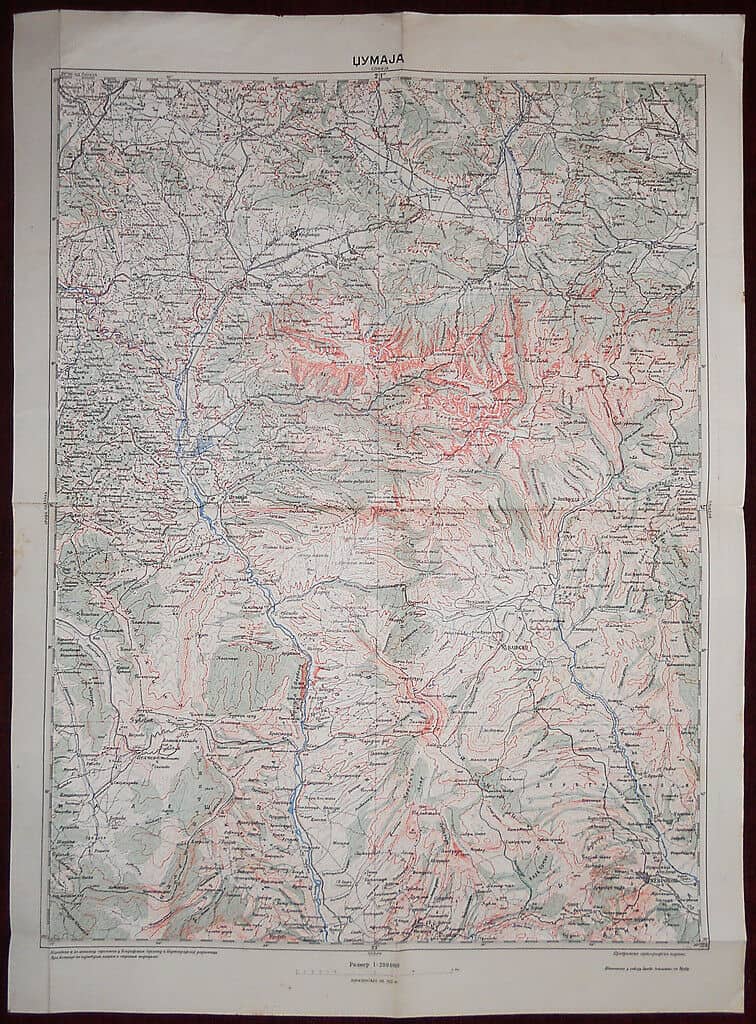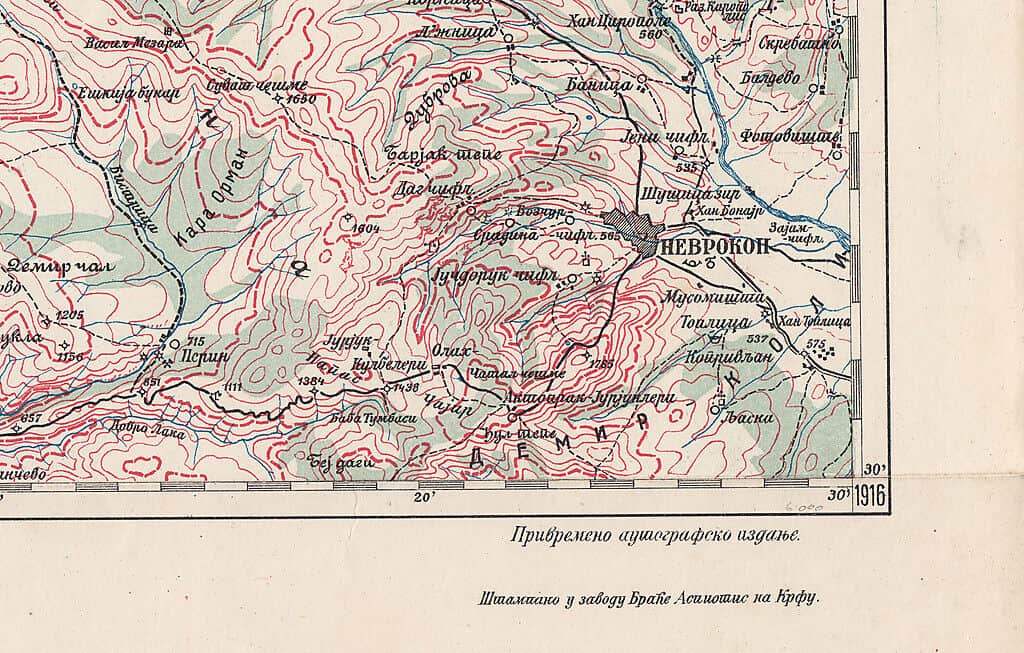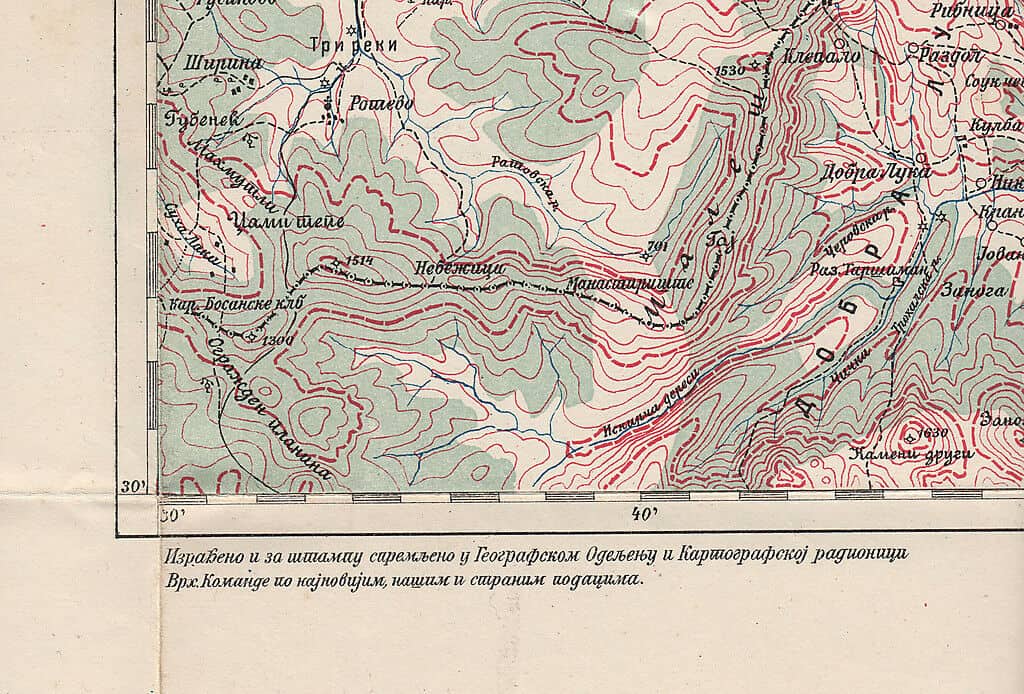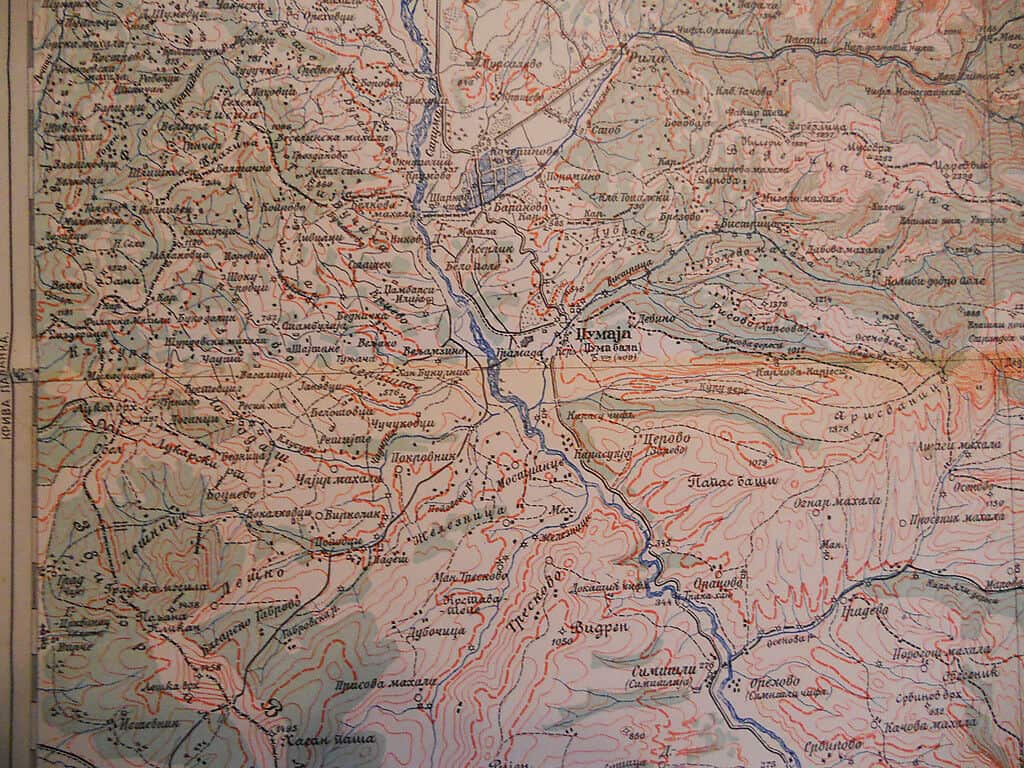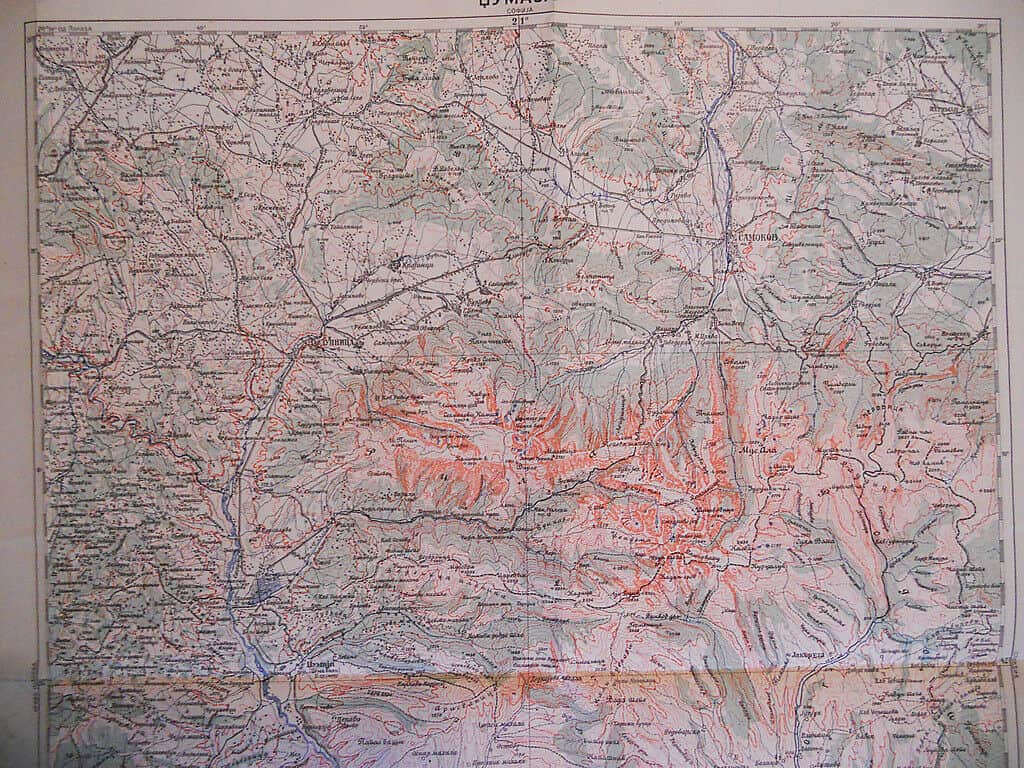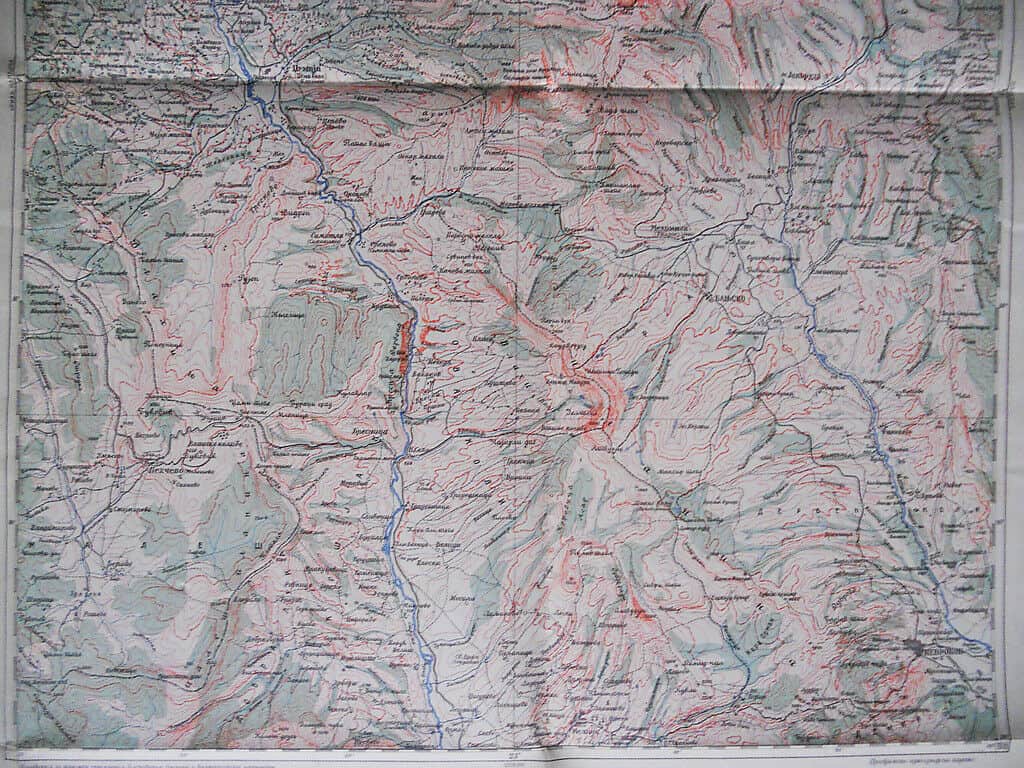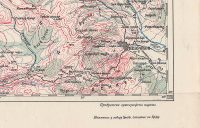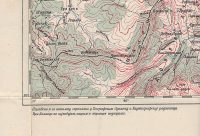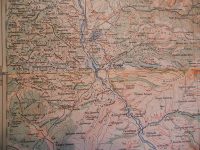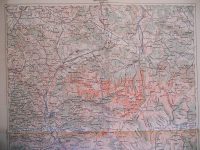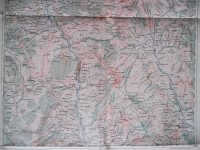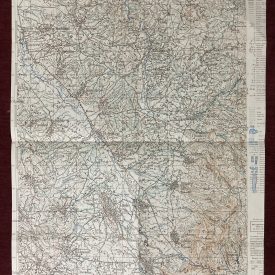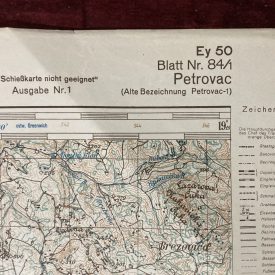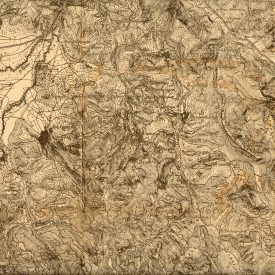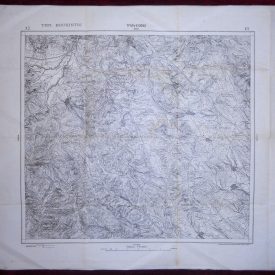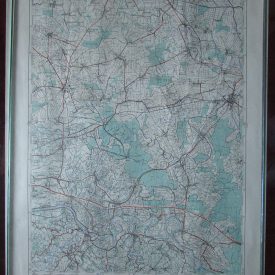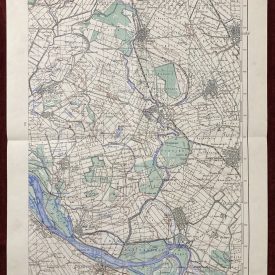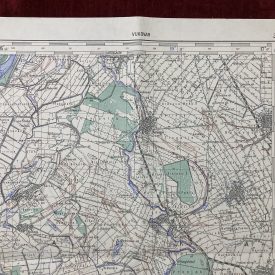RARE
ORIGINAL MILITARY TOPOGRAPHIC DETAILED MAP
Southwestern BULGARIA
Printed in very small circulation.
?????? (DZUMAJA, DJOUMAIA)
Temporary autographic release
P????? (scale): 1 : 200000.
Publisher: ?????????? ??????? ??????? ???????????? – ?????? (Geographical Department of Chief General Staff – Serbia).
Print: Department og Brothers Aspiotis on Corfu (Greece).
Dimensions: 67,3 x 64,7 cm.
Date: printed during WWI, probable 1916 – 1918.
***
Condition: wear, folded as issued, some small imperfections on the borders, small pale stains, pale stains on the verso.
For condition and details see picture. If you have any questions, please contact us.
This item will be shipped in a cardboard tube.
Bulgaria (Bulgarian: ????????, Balgariya, IPA: [b??’?arij?]), officially the Republic of Bulgaria (????????? ????????, transliterated: Republika Balgariya, IPA: [r?’publik? b??’?arij?]), is a country in Southeast Europe. Bulgaria borders Romania to the north, Serbia and Macedonia to the west, and Greece and Turkey to the south, and the Black Sea to the east. With a territory of 110,994 square kilometers (42,855 sq mi), it ranks as the 15th-largest country in Europe. The economy relies on local natural resources and the strongest sectors are heavy industry and agriculture.
The emergence of a unified Bulgarian ethnicity and state dates back to the 7th century AD. All Bulgarian political entities that subsequently emerged preserved the traditions of the First Bulgarian Empire, which at times covered most of the Balkans and became a cultural hub for the Slavs in the Middle Ages. With the downfall of the Second Bulgarian Empire in 1396, its territories came under Ottoman rule for nearly five centuries. The Russo-Turkish War of 1877–1878 resulted in the establishment of a third Bulgarian state, the independence of which was fully recognized in 1908. Shortly afterwards Bulgaria became involved in a series of major conflicts with its neighbours and allied with Germany in both World Wars. After World War II it became a people’s republic and was a part of the Warsaw Pact until the Revolutions of 1989, when the Communist Party allowed multi-party elections. Bulgaria transitioned to democracy and free market capitalism was introduced.
The government functions as a parliamentary democracy within a unitary constitutional republic. Bulgaria is a member of the European Union, NATO, the Council of Europe, a founding state of the OSCE, and has taken a seat in the UN Security Council three times.
Bulgaria’s population of 7.37 million people is predominantly urban and is concentrated mainly in the administrative centers of its 28 provinces. With 1.2 million people Sofia is the largest city, where most economic and political activities are concentrated. Bulgaria is home to some of the most ancient cultural artifacts in the world and is a historical crossroad of various civilizations.
History
Prehistory and antiquity
Prehistoric cultures in the Bulgarian lands include the Neolithic Hamangia culture[5] and Vinca culture,[6] the eneolithic Varna culture (5th millennium BC),[7] and the Bronze Age Ezero culture.[8] The Varna Necropolis serves as a tool for understanding the social hierarchy of the earliest European societies.[9]
The Thracians, one of the three primary ancestral groups of modern Bulgarians,[10] lived separated in various tribes until King Teres united most of them in the Odrysian kingdom around 500 BC.[11][12] They were eventually subjugated by Alexander the Great and later by the Roman Empire. After migrating from their original homeland, the easternmost South Slavs settled on the territory of modern Bulgaria during the 6th century and assimilated the Hellenized or Romanized Thracians. Eventually the élite of the Central Asian Bulgars incorporated all of them into a new state which formed upon khan Asparukh’s arrival on the Balkans.[13]
First Bulgarian Empire
Asparukh, son of Old Great Bulgaria’s khan Kubrat, migrated with several Bulgar tribes to the lower courses of the rivers Danube, Dniester and Dniepr. After 670, he crossed the Danube with a horde of up to 50,000 people[14] and conquered Moesia and Scythia Minor (Dobrudzha) from the Byzantine Empire, expanding his new kingdom further into the Balkan Peninsula.[15] The local south Slavic language was gradually adopted by the advancing Bulgars, who nevertheless preserved a dominant position over the Slavic majority.[16] A peace treaty with Byzantium in 681 and the establishment of a permanent capital at Pliska south of the Danube mark the beginning of the First Bulgarian Empire.[17]
Succeeding khans strengthened the Bulgarian state throughout the 8th and 9th centuries—Tervel established Bulgaria as a major military power by defeating a 26,000-strong Arab army during the Second Arab Siege of Constantinople;[18] Krum[19] doubled the country’s territory, killed Byzantine emperor Nicephorus I in the Battle of Pliska,[20] and introduced the first written code of law; Boris I abolished Tengriism in favor of Eastern Orthodox Christianity in 864,[21] and introduced the Cyrillic alphabet. Simeon the Great’s 34-year rule began in 893 and saw the largest territorial expansion of Bulgaria in its history,[22] along with a golden age of Bulgarian culture and a military supremacy over the Byzantine Empire, demonstrated in the Battle of Achelous.[23]
Khan Krum feasts with his nobles after the battle of Pliska. His servant (far right) brings the wine-filled skull cup of Emperor Nicephorus I.
After Simeon’s death, Bulgaria was weakened by wars with Croatians, Magyars, Pechenegs and Serbs and the spread of the Bogomil heresy.[24][25] Two consecutive Rus’ and Byzantine invasions resulted in the seizure of the capital Preslav by the Byzantine army in 971.[26] Under Samuil, Bulgaria somewhat recovered from these attacks and managed to conquer Serbia and Duklja,[27] but this rise ended when Byzantine emperor Basil II defeated its armies at Klyuch in 1014.[28] Samuil died shortly after the battle,[28] and by 1018 the Byzantines conquered the remaimed parts of the First Bulgarian Empire, putting it to an end.[29]
Second Bulgarian Empire
After conquering Bulgaria, Basil II retained the rule of the local nobility by incorporating them into Byzantine aristocracy as archons or strategoi,[30] and recognized the autocephaly of the Bulgarian Archbishopric of Ohrid, thus preventing discontent and revolts.[31] After his death Byzantine domestic policies changed and a series of unsuccessful rebellions broke out, the largest being led by Peter II Delyan. It was not until 1185 when Asen dynasty nobles Ivan Asen I and Peter IV organized a major uprising and succeeded in re-establishing the Bulgarian state, laying the foundations of the Second Bulgarian Empire.
The Second Bulgarian Empire under Tsar Ivan Asen II in the mid-13th century
The Asen dynasty set up the new capital capital in Tarnovo. Kaloyan, the third of the Asen monarchs, extended his dominions to Belgrade, Nish and Skopje; he acknowledged the spiritual supremacy of the Pope, and received a royal crown from a papal legate.[13] Cultural and economic growth persisted under Ivan Asen II (1218–1241), who extended Bulgaria’s control over Albania, Epirus, Macedonia and Thrace.[32] In his time the empire attained a prosperity unknown by that moment—commerce, the arts and literature flourished.[13] Tarnovo became a major economic and religious center—a “Third Rome”, unlike the already declining Constantinople.[33]
The country’s military and economic might declined after the end of the Asen dynasty in 1257, facing internal conflicts, constant Byzantine and Hungarian attacks and Mongol domination.[34][13] By the end of the 14th century, factional divisions between the feudal landlords and the spread of Bogomilism had caused the Second Bulgarian Empire to split into three small tsardoms—Vidin, Tarnovo and Karvuna—and several semi-independent principalities that fought among themselves, and also with Byzantines, Hungarians, Serbs, Venetians and Genoese. In the late 14th century the Ottoman Turks, who had already started their invasion of the Balkans, conquered most Bulgarian towns and fortresses south of the Balkan Mountains and began their northwards conquest.[35]
Ottoman rule and national awakening
In 1393, the Ottomans captured Tarnovo after a three-month siege. In 1396, the Vidin Tsardom fell after the defeat of a Christian crusade at the Battle of Nicopolis. With this, the Ottomans finally subjugated all Bulgarian lands south of the Danube.[36][37][38] North of the Danube, where a significant number of Bulgarian nobility and common folk remained, the population was under the jurisdiction of various autonomous, predominately Wallachian-led Christian principalities, where the Bulgarian alphabet continued to be used[39] and many cities, like the Wallachian capital of Targovishte, kept their Bulgarian names. The nobility in these principalities continued to be known by their Bulgarian titles of bolyars and regularly helped the southern population to migrate north.[40] The southern nobility however, was eliminated and the peasantry was enserfed to Ottoman masters.[41] The population lost its national consciousness under the oppression, intolerance and misgovernment of the invaders.[42] Bulgarian culture was suppressed and the educated clergy fled to other countries,[43] while Bulgarians were considered an inferior class of people and were subjected to heavy imposts.[13]
Throughout the nearly five centuries of Ottoman rule, the Bulgarian people responded to their oppression by strengthening the haydut tradition,[45] and attempted to re-establish their state by organizing several revolts, most notably the First and Second Tarnovo Uprisings (1598 / 1686) and Karposh’s Rebellion (1689). The National awakening of Bulgaria became one of the key factors in the struggle for liberation, resulting in the 1876 April uprising—the largest and best-organized Bulgarian rebellion. About 15,000[45] to 30,000[46] Bulgarians were killed as the Ottoman authorities put down the uprising. The massacres prompted the Great Powers to take action.[46] They convened the Constantinople Conference in 1876, but their decisions were rejected by the Ottoman authorities. This allowed the Russian Empire to seek a solution by force without risking military confrontation with other Great Powers, as had happened in the Crimean War.[46] In 1877 Russia declared war on the Ottoman empire, and with the help of Bulgarian volunteers defeated the Ottoman forces. The Treaty of San Stefano, which set up an autonomous Bulgarian principality on the territories of the Second Bulgarian Empire, was signed on 3 March 1878.[47][48]
The other Great Powers immediately rejected the treaty out of fear that such a large country in the Balkans might threaten their interests.[47] The subsequent Treaty of Berlin provided for a much smaller autonomous state comprising Moesia and the region of Sofia, leaving large populations of Bulgarians outside the new country.[47][49] This defined Bulgaria’s militaristic approach to foreign affairs and its participation in four wars during the first half of the 20th century.[50] The Bulgarian principality won a war against Serbia and incorporated the semi-autonomous Ottoman territory of Eastern Rumelia in 1885, and proclaimed itself an independent state on 22 September 1908.[51]
Third Bulgarian State
Main articles: History of Bulgaria (1878–1946), People’s Republic of Bulgaria, and History of Bulgaria since 1989
Tsar Ferdinand I and his cabinet prepare to announce the declaration of independence, 1908
In the years following the achievement of independence Bulgaria was becoming increasingly militarized and was referred to as “the Balkan Prussia”.[52][53] Between 1912 and 1918, Bulgaria became involved in a string of three consecutive conflicts—the Balkan Wars and World War I. After a disastrous defeat in the Second Balkan War, Bulgaria again found itself fighting on the losing side as a result of its alliance with the Central Powers in World War I. Despite fielding more than a quarter of its population in a 1,200,000-strong army[54][55] and achieving several decisive victories at Doiran and Monastir, the country capitulated in 1918. The war resulted in significant territorial losses,[45] a total of 412,000 casualties, and a wave of more than 253,000[56] refugees who put an additional strain on the already ruined national economy.
The political unrest resulting from these losses led to the establishment of a royal authoritarian dictatorship by Tsar Boris III (1918–1943). Bulgaria entered World War II in 1941 as a member of the Axis but declined to participate in Operation Barbarossa and saved its Jewish population from deportation to concentration camps.[57] In the summer of 1943 Boris III died suddenly, an event which pushed the country into political turmoil as the war turned against Nazi Germany and the Communist guerilla movement gained momentum.[58] Following strikes and unrest, in September 1944 the Communist-dominated Fatherland Front took power, ending the alliance with Nazi Germany and joining the Allied side until the end of the war in 1945.[59]
The Communist uprising of 9 September 1944 led to the abolition of monarchic rule, but it was not until 1946 that a people’s republic was established.[60] It became a part of the Soviet sphere of influence under the leadership of Georgi Dimitrov (1946–1949). Bulgaria installed a Soviet-style planned economy with some market-oriented policies emerging on an experimental level[61] under Todor Zhivkov (1954–1989). By the mid-1950s standards of living rose significantly.[62] Lyudmila Zhivkova, daughter of Zhivkov, promoted Bulgaria’s national heritage, culture and arts worldwide.[63] On the other hand, an assimilation campaign of the late 1980s directed against ethnic Turks resulted in the emigration of some 300,000 of them to Turkey.[64][65] On 10 November 1989, the Bulgarian Communist Party gave up its political monopoly, Zhivkov resigned, and Bulgaria embarked on a transition from a single-party republic to a parliamentary democracy.[66]
Zhelyu Zhelev, the first democratically elected president of Bulgaria[67] with George H. W. Bush (right) in 1990
The first free elections took place in June 1990 and were won by the moderate wing of the Communist Party (the Bulgarian Socialist Party—BSP).[68] A new constitution that provided for a relatively weak elected President and for a Prime Minister accountable to the legislature was adopted in July 1991. The new system eventually failed to improve living standards or create economic growth—the average quality of life and economic performance actually remained lower than in the times of Communism well into the early 2000s.[69] A reform package introduced in 1997 restored positive economic growth, but living standards continued to suffer.[70] After 2001 economic, political and geopolitical conditions improved greatly,[71] and Bulgaria achieved High Human Development status.[72] It became a member of NATO in 2004 and of the European Union in 2007.
Geography
Main article: Geography of Bulgaria
Bulgaria’s geographic coordinates are 43° N 25° E.[73] Its total area is 110,994 square kilometers, which ranks it as the 105th-largest country in the world.[74][75] A total of 1,808 kilometers of land borders are shared with five countries—Greece (494 km), Macedonia (148 km), Romania (608 km), Serbia (318 km) and Turkey (240 km). The coastline has a length of 354 kilometers.[76]
Bulgaria has several notable topographical features: the Danubian Plain, which runs along both sides of the border with Romania; the Balkan Mountains; the Thracian Plain; and the Rhodope Mountains.[76] The southern edge of the Danubian Plain slopes upward into the foothills of the Balkans, which are highest in the western part of the country. The Thracian Plain is roughly triangular, beginning near Sofia in the west and broadening as it reaches the Black Sea coast.[76]
Prolom view.jpg Observers Black sea coast.jpg
Left: A view of the Sredna Gora region
Right: The Black Sea coast near Chernomorets
About 30 percent of the land is made up of plains, while plateaus and hills account for 41 percent.[77] The mountainous southwest of the country has two alpine ranges—Rila and Pirin, and further east stand the lower but more extensive Rhodope Mountains.[76] The Balkan mountain chain runs west-east through the middle of the country, north of the Rose Valley. Hilly countryside and plains lie to the southeast, along the Black Sea coast, and along Bulgaria’s main river, the Danube, to the north. Bulgaria’s highest point is Musala at 2,925 meters (9,596 ft)[78] and its lowest point is the sea level at 0 meters.
The climate is temperate, with cold winters and hot summers. Considering its relatively small size, Bulgaria has substantial climatic variation because it is located at the meeting point of Mediterranean and continental air masses and because its mountains partition climatic zones.[76] Precipitation averages about 630 millimeters (24.8 in) per year.[79] In the lowlands rainfall varies between 500 and 800 millimeters (19.7 and 31.5 in), and in the mountain areas between 1,000 and 2,500 millimeters (39.4 and 98.4 in). Drier areas include Dobrudja and the northern coastal strip, while the higher parts of the Rila, Pirin, Rhodope Mountains, Stara Planina, Osogovska Mountain and Vitosha receive the highest levels of precipitation.
Imperial eagles have a gradually growing population in Bulgaria.[80]
The country has a dense network of about 540 rivers, most of them—with the notable exception of the Danube—short and with low water levels.[81] Most rivers flow through mountainous areas. The longest river located solely in Bulgarian territory, the Iskar, has a length of 368 kilometers (229 mi). Other major rivers include the Struma and the Maritsa in the south.[76]
Environment and wildlife
Bulgaria has signed and ratified the Kyoto protocol[82] and has completed the protocol’s objectives by achieving a 30 percent reduction of carbon dioxide emissions from 1990 to 2009.[83] However, pollution from outdated factories and metallurgy works, as well as severe deforestation, continue to be major problems.[84] Urban areas are particularly affected mostly due to energy production from coal-based powerplants and automobile traffic,[85][86] while pesticide usage in the agriculture and antiquated industrial sewage systems have resulted in extensive soil and water pollution with chemicals and detergents.[87] Bulgaria remains the only EU member which does not recycle municipal waste,[88] although an electronic waste recycling plant was put in operation in June 2010.[89] The situation has improved in recent years, and several government-funded programs have been initiated in order to reduce pollution levels.[87]
Three national parks, 11 nature parks[90] and 17 biosphere reserves[91] exist on Bulgaria’s territory. Nearly 35 percent of its land area consists of forests,[92] where some of the oldest trees in the world, such as Baikushev’s Pine and the Granit oak,[93] have grown. The flora of Bulgaria encompasses more than 3,800 species of which 170 are endemic and 150 are considered endangered.[94] The fauna is represented prominently by the brown bear and the jackal,[95] while the Eurasian lynx and the Eastern imperial eagle have small, but growing populations.[96]
Politics
Main article: Politics of Bulgaria
The national assembly of Bulgaria
Bulgaria functions as a parliamentary democracy in which the prime minister occupies the most powerful executive position.[71] The political system has three separate branches of power—legislative, executive and judicial, with universal suffrage for citizens 18 years of age and older. Elections are supervised by an independent Central Election Commission that includes members from all major political parties. Parties must register with the commission prior to participating in a national election.[97] Normally, the prime minister-elect is the leader of the party receiving the most votes in parliamentary elections.[98]
The National Assembly (??????? ????????) consists of 240 deputies, each elected for four-year terms by direct popular vote. The National Assembly has the power to enact laws, approve the budget, schedule presidential elections, select and dismiss the Prime Minister and other ministers, declare war, deploy troops abroad, and ratify international treaties and agreements. The president serves as the head of state and commander-in-chief of the armed forces. While unable to initiate legislation other than constitutional amendments, the President can return a bill for further debate, although the parliament can override the President’s veto by vote of a simple majority of all MPs.[71] Boyko Borisov, leader of the centre-right party Citizens for European Development of Bulgaria (Grazhdani za Evropeysko Razvitie na Bulgaria, GERB), became prime minister on 27 July 2009,[99] and Georgi Parvanov was re-elected as a president in 2005. In 2011 Rosen Plevneliev from GERB was elected to succeed Parvanov, receiving 52.5% of the votes on the second round against 47.5% for his Socialist Party opponent Ivaylo Kalfin.[100]
The legal system recognizes the Acts of Parliament as a main source of law, and is a typical representative of the Romano-Germanic law family.[101] The judiciary is a separate branch and is overseen by the Ministry of Justice, while the highest courts of appeal—the Supreme Administrative Court and Supreme Court of Cassation—rule on the application of laws in lower courts.[102] The Supreme Judicial Council manages the system and appoints judges. Bulgaria’s judiciary remains one of Europe’s most corrupt and inefficient.[103][104]
Law enforcement organizations are mainly subordinate to the Ministry of Interior.[105] The National Police Service is fights general crime and supports the operations of other law enforcement agencies, such as the National Investigative Service and the Central Office for Combating Organized Crime.[106] The Police Service has criminal and financial sections and national and local offices, and fields 27,000 police officers.[107] The Ministry of Interior also heads the Border Police Service and the National Gendarmerie—a specialized branch for anti-terrorist activity, crisis management and riot control. The State Agency for National Security, a specialized body for counterintelligence, was established in 2008 with the aim to eliminate threats to national security.[108]
Administrative divisions
Main articles: Provinces of Bulgaria and Municipalities of Bulgaria
Bulgaria is a unitary state.[109] Between 1987 and 1999 the administrative structure consisted of nine provinces (oblasti, singular oblast). In 1999, in parallel with the decentralization of the economic system, a new administrative structure was adopted.[110] It includes 27 provinces and a metropolitan capital province (Sofia-Grad). All areas take their names from their respective capital cities. The provinces subdivide into 264 municipalities.
Regional governors are named by the national Council of Ministers, providing for a highly centralized state. Municipalities are run by mayors, who are elected to four-year terms, and by municipal councils, which are directly elected legislative bodies. Subnational jurisdictions are heavily dependent on the central government for funding.[111]
Bulgaria Aministrative Provinces numbered.png
Blagoevgrad
Burgas
Dobrich
Gabrovo
Haskovo
Kardzhali
Kyustendil
Lovech
Montana
Pazardzhik
Pernik
Pleven
Plovdiv
Razgrad
Rousse
Shumen
Silistra
Sliven
Smolyan
Sofia Province
Stara Zagora
Targovishte
Varna
Veliko Tarnovo
Vidin
Vratsa
Yambol
Foreign relations and military
Main articles: Foreign relations of Bulgaria and Military of Bulgaria
Bulgaria became a member of the United Nations in 1955 and since 1966 has been a non-permanent member of the Security Council three times, most recently from 2002 to 2003.[112] Bulgaria was also among the founding nations of the OSCE in 1975. It joined NATO on 29 March 2004, signed the European Union Treaty of Accession on 25 April 2005,[113][114] and became a full member of the European Union on 1 January 2007.[115] Euro-Atlantic integration has been a priority for the country since the Fall of Communism, although even the Communist leadership had aspirations of leaving the Warsaw Pact and joining the European Communities as early as 1987.[116][117][118] Bulgaria’s relationship with its neighbors since 1990 has generally been good. The country has played an important role in promoting regional security.[119]
A Bulgarian Air Force Mikoyan MiG-29 fighter jet at Graf Ignatievo Air Base
Bulgaria remained free of foreign deployments on its territory until 2001, when it hosted six KC-135 Stratotanker aircraft and 200 support personnel for the war effort in Afghanistan, which was the first stationing of foreign forces on its territory since World War II.[120] In April 2006 Bulgaria and the United States signed a defense cooperation agreement providing for the usage of the Bezmer and Graf Ignatievo air bases, the Novo Selo training range, and a logistics centre in Aytos as joint military facilities. The facilities serve to enhance Bulgaria’s military capabilities by means of cooperative training.[121] Foreign Policy magazine lists Bezmer Air Base as one of the six most important overseas facilities used by the USAF.[122]
The military of Bulgaria, an all-volunteer body, consists of three services—land forces, navy and air force. The country maintains a total of 913 troops deployed abroad as part of various UN and NATO missions. Historically, Bulgaria deployed significant numbers of military and civilian advisors in Socialist-oriented countries, such as Nicaragua[123] and Libya (more than 9,000 personnel).[124]
Following a series of reductions beginning in 1990, the number of active troops has contracted from 152,000 in 1988[125] to about 32,000 today,[126] supplemented by a reserve force of 303,000 soldiers and officers and 34,000 paramilitary servicement.[127] The inventory consists of equipment mostly of Soviet origin, such as MiG-29 fighters, SA-10 Grumble SAMs and SS-21 Scarab short-range ballistic missiles. Military spending in 2009 cost $1.19 billion.[128]
Economy
Main article: Economy of Bulgaria
Sofia, the financial heart of the country
Bulgaria has an industrialized free market economy[129] in the upper middle income range,[130] with a large private sector accounting for more than 80 percent of GDP.[131] From a largely agricultural country with 80 percent of its population in rural areas in 1948, by the 1980s Bulgaria transformed into an industrial economy with scientific and technological research as its top priorities.[132] The loss of COMECON markets in 1990 and the subsequent “shock therapy” of the planned system caused a sharp drop in industrial and agricultural production, and ultimately an economic collapse in 1997.[133][134] After 2001, Bulgaria experienced rapid economic growth,[133] even though its income level remains one of the lowest within the EU with an average monthly wage of 689 leva (354 euro).[135] Bulgarian PPS GDP per capita stood at 44 percent of the EU average in 2010 according to Eurostat data,[136] while the cost of living was 51 percent of the EU average.[137] The currency is the lev, which is pegged to the euro at a rate of 1.95583 lev? for 1 euro.[138]
Amidst the late-2000s financial crisis, unemployment rates increased to 10.1 percent in 2010,[139] while GDP growth contracted from 6.2 (2008) to –5.5 percent(2009).[140] The crisis had a negative impact mostly on industry, with a 10 percent decline in the national industrial production index, a 31 percent drop in mining, and a 60 percent drop in “ferrous and metal production”.[141] Positive growth was restored to 0.2 percent in 2010.[140]
Corruption in the public administration and a weak judiciary have hampered Bulgaria’s economic development.[142][143] However, it ranks 28th in the Economic Freedom of the World index,[144] has the lowest personal and corporate income tax rates in the European Union,[145] and the second-lowest public debt of all member states at 16.2 percent of GDP in 2010.[146] In 2010, GDP (PPP) was estimated at $97.1 billion, with a per capita value of $12,934.[2] Yugozapaden is the most developed region of the country with a per capita PPS GDP of $25,130.[147] The services sector accounts for 64.6 percent of GDP, followed by industry with 30.1 percent and agriculture with 5.3 percent.[148] The total labor force amounts to 2.5 million people.[149]
Even though relatively poor in terms of natural resources, local deposits of iron, copper, lead and coal are vital for Bulgaria’s manufacturing sector.[150] Major industries include the extraction of metals and minerals, production of chemicals, machinery, petroleum refinement,[151] steel[152] and vehicle components production.[153] Primary industrial exports are clothing, iron and steel, machinery and refined fuels.[154] The mining sector and its related industries employ a total of 120,000 people and generate about 5 percent of the country’s GDP with $3.51 billion worth of exports.[155] The country is the 4th-largest gold producer and the 6th-largest coal producer in Europe.[155][156] In 2008 the electronics industry marked more than $260 million in exports, primarily of components, computers and consumer electronics.[157] Another major area of Bulgaria’s industry is military equipment, the exports of which amounted to $358 million in 2010,[158] including the manufacture of 50 percent of all radar systems for Northrop Grumman’s UK branch.[159]
In contrast with the industrial sector, agriculture has marked a decline since the beginning of the 2000s, with production in 2008 amounting to only 66 percent of that between 1999 and 2001[160] and an overall drop in cereal and vegetable yields with nearly 40 percent since 1990.[161] Bulgaria nevertheless remains a net agricultural and food exporter and two-thirds of its exports are to OECD countries.[162] The country is the largest global producer of perfumery essential oils such as lavender and rose oil.[120][163] A five-year modernization and development program was launched by the government in 2007, aimed at strengthening the agructultural sector by investing a total of 3.2 billion euro.[164]
In recent years Bulgaria has emerged as an attractive tourist destination as it has some of the least expensive resorts in Europe[165] and holds some of the last deserted beaches on the continent.[166] Lonely Planet ranked Bulgaria among its top 10 travel destinations for 2011.[167] More than 40 percent of all 9,000,000 annual visitors are Greeks, Romanians and Germans.[168] Main destinations include the capital Sofia, the medieval capital Veliko Tarnovo,[169] coastal resorts Golden Sands and Sunny Beach and winter resorts Bansko, Pamporovo and Borovets.
Infrastructure
Main articles: Energy in Bulgaria, Transport in Bulgaria, and Communications in Bulgaria
Wind turbines near cape Kaliakra.
Although it has relatively few reserves of fossil fuels, Bulgaria’s well-developed energy sector and strategic geographical location make it a key European energy hub.[170] Nearly 34 percent of the electricity is produced by the nuclear power station at Kozloduy[171] and public opinion is strongly in support of nuclear energy development.[172] Recent years have seen a rapid increase in electricity production from renewable energy sources such as wind and solar power,[173] making Bulgaria one of the fastest-growing wind energy producers in the world.[174] The country aims at producing 16 percent of its electricity from renewable energy sources by 2020.[175]
Bulgaria’s national road network has a total length of 40,231 kilometers (24,998 mi),[176] of which 39,587 kilometers (24,598 mi) are paved, but nearly half of them fall into the lowest international rating for paved roads.[177] Railroads are a major mode of freight transportation, although highways carry a progressively larger share of freight. Bulgaria has 6,238 kilometers (3,876 mi) of railway track[177] and plans to construct a high-speed line by 2017, at a cost of €3 bln.[178][179] Sofia and Plovdiv are major air travel hubs, while Varna and Burgas are the principal maritime trade ports.[177]
Bulgaria’s extensive telecommunications network is generally antiquated and requires substantial modernization. Telephone service is available in most villages, and a central digital trunk line connects most regions.[177] Currently there are three active mobile phone operators—Mtel, GLOBUL and Vivacom.[180] The number of Internet users has increased rapidly since 2000—from 430,000 their number grew to 1,545,100 in 2004, and 3.4 million (48 percent penetration rate) in 2010.[181] Bulgaria has the fastest average Broadband Internet speed in the world after South Korea and Romania.[182]
Science and technology
Main article: Science and technology in Bulgaria
Tower of the 200 cm (79 in) telescope at the Rozhen Observatory.
In 2010 Bulgaria spent 0.25 percent of its GDP on scientific research,[183] which represents one of the lowest scientific budgets in Europe.[184] Chronic underinvestment in the sector since 1990 forced many scientific professionals to leave the country.[185] As a result, Bulgaria’s economy scores low in terms of innovation, competitiveness and high-value added exports.[186][187]
The Bulgarian Academy of Sciences (BAS) is the leading scientific institution in the country and employs most of Bulgaria’s researchers in its numerous branches. The principal areas of research and development are energy, nanotechnology, archaeology and medicine.[183] With major-general Georgi Ivanov flying on Soyuz 33 in 1979, Bulgaria became the 6th country in the world to have an astronaut in space. It has deployed its own experiments on various missions, such as RADOM-7[188] dosimeters on the International Space Station and Chandrayaan-1 and space greenhouses (a Bulgarian invention) on the Mir space station.[189] In 2011 the government announced plans to reboot the space program by producing a new microsatellite and joining the European Space Agency.[190]
Due to its large-scale computing technology exports to COMECON states, in the 1980s Bulgaria became known as the Silicon Valley of the Eastern Bloc.[191] The country ranked 8th in the world in 2002 by total number of ICT specialists, outperforming countries with far larger populations,[192] and it operates the only supercomputer in the Balkan region, an IBM Blue Gene/P, which entered service in September 2008.[193][194]
Demographics
Main article: Demographics of Bulgaria
A group of Bulgarian men in 1926
According to the 2011 census, the population of Bulgaria is 7,364,570 people,[195] down from a peak of 9 million inhabitants in 1989. Bulgaria has had negative population growth since the early 1990s,[196] when the collapse of the economy caused some 800,000 people—mostly young adults—to emigrate by 2004.[197] The population continues to decrease with 30,000 people per year[198] and the growth rate is the lowest of any sovereign country in the world.[199]
Comprising 84.8 percent of the population,[195] Bulgarians are the main ethnic group, followed by the Turkish and Roma minorities (8.8 and 4.9 percent, respectively). Of the remaining 1.5 percent, 0.7 comprise some 40 smaller minorities, while 0.8 percent of the population have not declared their ethnicity. Bulgarian is the only official language, spoken by about 5,659,000 people (85 percent) as a mother tongue.[195] Bulgarian is the most ancient Slavic language, with certain grammatical peculiarities distinguishing it from the other languages in this group.[200]
Most of the population (76 percent) self-identify as Orthodox Christian.[195] The Bulgarian Orthodox Church gained autocephalous status in 927 AD,[201][202] making it the earliest Slavic Orthodox Church.[203][204] Other religious denominations include Islam (10 percent), Roman Catholicism (0.8 percent) and Protestantism (1.1 percent); 12.1 percent of the population practice other beliefs or did not state their religion.[195] Bulgaria regards itself officially as a secular state. The Constitution guarantees religious freedom, but appoints Orthodoxy as a “traditional” religion.[205]
The library of Sofia University
Government estimates from 2003 put the literacy rate at 98.6 percent; approximately the same for both sexes. Bulgaria has traditionally had high educational standards.[206] The Ministry of Education, Youth and Science funds all public educational establishments, sets criteria for textbooks and oversees the publishing process.[207] The State provides education in its schools free of charge, except for higher education establishments.[206] The educational process spans through 12 grades, where grades one to eight are the primary level and nine to twelve are the secondary level.[207] Secondary level establishments can be technical, vocational, general or profile-oriented, while higher education consists of a 4-year bachelor degree and a 1-year master’s degree.[208]
Life expectancy is 73.6 years, below the European union average.[209] The primary causes of death are similar to those in other industrialized countries, mainly cardiovascular diseases, neoplasms and respiratory diseases.[210] Bulgaria has a universal healthcare system financed by taxes and health insurance contributions.[210] The National Health Insurance Fund (NHIF) pays a gradually increasing portion of the costs of primary healthcare. Between 2002 and 2004, healthcare expenditures in the national budget increased to 4.3 percent, with the NHIF accounting for more than 60 percent of annual expenditures.[211] The healthcare budget amounted to 4.2 percent of GDP in 2010, or about 1.3 billion euro.[212] Bulgaria has 181 doctors per 100,000 people, above the EU average.[213]
Most Bulgarians (72.5 percent) reside in urban areas.[214] Bulgaria has the highest home ownership rate in the world; about 97 percent of the population own a private home.[215] There is also a very high rate of household appliances ownership, such as television sets (97.9 percent of all households), refrigerators (93.3 percent) and telephones (90.6 percent), and relatively high rates for computers (42.9 percent) and automobiles (41.9 percent). The average rates in all categories are substantially higher in Sofia, by far the largest settlement in the country and the 12th largest city in the European Union with a population of more than 1,200,000 people.[195]
Culture
Main article: Culture of Bulgaria
Worldwide usage of the Cyrillic alphabet
Traditional Bulgarian culture contains mainly Thracian, Slavic and Bulgar heritage, along with Greek, Roman, Ottoman, Persian and Celtic influences.[216][217][218] Traces of Gothic culture also exist on Bulgaria’s territory, as testified by the Wulfila Bible—the first book written in a Germanic language, created in Nicopolis ad Istrum in northern Bulgaria during the 4th century.[219][220]
Bulgaria has the third-largest total number of uncovered archaeological sites in Europe after Italy and Greece.[221] In 1972 the oldest golden treasure in the world was discovered in a necropolis near Varna, consisting of coins, weapons and jewelry that date back to 4,600 BC.[222] The Varna necropolis also reveals evidence of the first European civilization.[120] Nine historical and natural objects have been inscribed in the list of UNESCO World Heritage Sites: the Madara Rider, the Thracian tombs in Sveshtari and Kazanlak, the Boyana Church, the Rila Monastery, the Rock-hewn Churches of Ivanovo, Pirin National Park, Sreburna Nature Reserve and the ancient city of Nesebar.[223] Nestinarstvo, a ritual fire-dance of Thracian origin,[224] is in the list of UNESCO Intangible Cultural Heritage.[225]
Ancient Roman architecture in Plovdiv, one of the oldest cities in the world, continuously inhabited since at least 3,000 BC.[226]
Both the First and the Second Bulgarian empires functioned as the center of Slavic culture during much of the Middle Ages, exerting considerable cultural influence over the Eastern Orthodox Slavic world by means of the Preslav, Ohrid and Tarnovo literary schools.[227][228][229] The Cyrillic alphabet, used as a writing system to many languages in Eastern Europe and Asia, originated in the Preslav Literary School around the 9th century AD.[230] However, Bulgaria’s advancement in the arts ended with the Ottoman conquest when many masterpieces were destroyed, and artistic activities did not re-emerge until the National Revival in the 19th century.[231] After the Liberation war, Bulgarian literature quickly adopted European literary currents such as Romanticism and Symbolism. Notable authors include Ivan Vazov, Pencho Slaveykov, Peyo Yavorov, Yordan Radichkov and Tzvetan Todorov.[232][233] In 1981 Bulgarian-born writer Elias Canetti was awarded the Nobel Prize in Literature.[234]
Bulgarian folk music has slowly developed throughout the ages as a fusion of Eastern and Western influences. It contains Far Eastern, Oriental, medieval Eastern Orthodox and standard Western European tonalities and modes.[235] Folk music has a distinctive sound and uses a wide range of traditional instruments, such as gudulka, gaida (bagpipe), kaval and tupan. One of its most distinguishing features is the extended rhythmical time, which has no equivalent in the rest of European music.[120] The State Television Female Vocal Choir is the most famous performing folk ensemble, and received a Grammy Award in 1990.[236] Bulgarian musical composition can be traced back to the early Middle Ages and the works of Yoan Kukuzel (c. 1280–1360).[237] Classical music, opera and ballet are represented by composers Emanuil Manolov, Pancho Vladigerov and Georgi Atanasov and singers Ghena Dimitrova and Boris Hristov.[238][239][240][241]
Rakiya distilled in Elena, central Bulgaria
Bulgaria’s religious visual arts heritage includes frescoes, murals and icons, many of them produced by the medieval Tarnovo Artistic School.[242] Vladimir Dimitrov, Nikolay Diulgheroff and Christo are some of the most famous modern Bulgarian artists.[231]
Bulgarian cuisine is similar to those of other Balkan countries and demonstrates a strong Greek and Turkish influence.[243] Yogurt, lukanka, banitsa, shopska salad, lyutenitsa and kozunak are among the best-known Bulgarian foods. Oriental dishes such as moussaka, gyuvech, and baklava are also present. There is a notable variety of salads, and meat consumption is lower than the average for Europe.[243] Rakiya is a traditional Bulgarian fruit brandy which has been consumed as early as the 14th century.[244] Bulgarian wine is known for its Traminer, Muskat and Mavrud sorts, of which up to 200,000 tonnes are produced annually.[245][246]
Bulgaria performs well in sports such as wrestling, weight-lifting, boxing, gymnastics and tennis.[247] The country fields one of the leading men’s volleyball teams, ranked 6th in the world according to the 2011 FIVB rankings.[248] Football is by far the most popular sport in the country.[247] Some famous players are Manchester United forward Dimitar Berbatov and Hristo Stoichkov, twice winner of the European Golden Shoe and the most successful Bulgarian player of all time.[249] Prominent domestic football clubs include PFC CSKA Sofia[250][251] and PFC Levski Sofia. Bulgaria’s best performance at World Cup finals came in 1994, where the national team consecutively eliminated Greece, Germany and Argentina and finished 4th.[247] Bulgaria participates in most Olympic competitions since its first appearance at the 1896 games, when it was represented by Charles Champaud.[252] The country has won a total of 218 medals: 52 gold, 86 silver, and 80 bronze,[253] which puts it at 24th place in the all-time ranking.
supreme supremewidgets supremeauctiononlinesoftware.widgets.EbayGalleryZ. supremewidgets supremeauctiononlinesoftware.widgets.GalleryBasicFree. supremewidgets supremeauctiononlinesoftware.widgets.FeedbackWidgetBasicFree.

